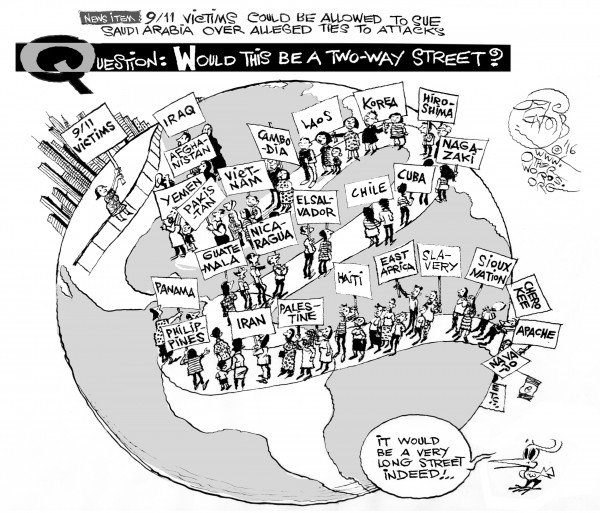
~ ~ ~
These announcements are interactive. Click on them for more information.
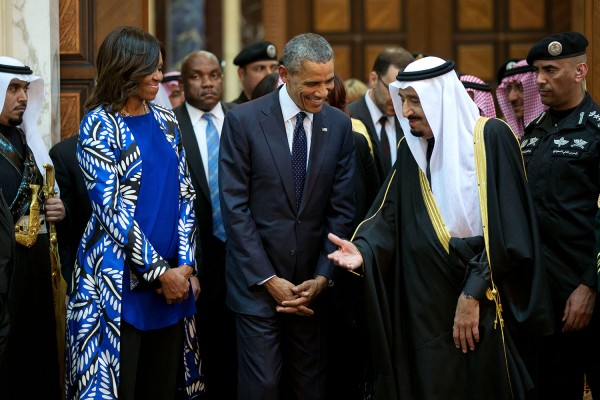
Are US-Saudi relations finally souring?
by Alli McCracken — OtherWords
Congress recently passed the Justice Against Sponsors of Terrorism Act (JASTA) allowing families of victims of the September 11, 2001 attacks to sue other governments, including Saudi Arabia, for possible damages.
Despite threats by the Saudi government to sell billions of dollars’ worth of their assets and reexamine the bilateral relationship with the United States, Congress snubbed the monarchy and passed the bill, then overturned a presidential veto to it almost unanimously.
This is just one of the most overt pieces of evidence that the historically cozy US-Saudi relationship is on the decline.
A couple years ago, few questioned the decades-old political alliance between the United States and Saudi Arabia. But, amidst a heated election season in the United States, the bloody Saudi-waged war on Yemen has led to a wave of protest by Capitol Hill lawmakers and human rights organizations who want to reexamine this relationship.
During the Obama administration, a whopping 42 weapons deals have been brokered between the US and Saudi governments, worth over $110 billion. However, the latest deal, amounting to $1.15 billion, was met with unprecedented opposition over concerns of apparent Saudi war crimes in Yemen.
In a letter to the White House, 64 members of the House of Representatives asked President Obama to withdraw the weapons deal, and 27 Senators voted in favor of a resolution opposing the deal.
Humanitarian and human rights organizations like Oxfam, Amnesty International, and Human Rights Watch got involved in the opposition movement too, pointing to the nearly 10,000 deaths and injuries caused by the Saudi war on Yemen using US-made weapons.
Major media outlets like The New York Times penned editorials slamming the deal.
This is a welcome and overdue change for many who believe that Saudi Arabia’s war crimes in Yemen shouldn’t go unpunished, but it’s also an important moment to rethink the entirety of the US alliance with Saudi Arabia and the US role in the Middle East.
The tension between the United States and the Saudi monarchy isn’t just manifesting in the legislative branch of the government — the executive branch has also sent clear signals that the tides are turning.
In 2015, President Obama, along with Secretary of State John Kerry, orchestrated one of the most successful diplomatic wins of the administration: the Iran nuclear deal. The Saudi monarchy, nervous about the geopolitical and sectarian trends in the Middle East apparently aligning against them, felt threatened by the deal and lobbied in Washington against it.
This didn’t stop the White House and State Department from pushing the deal through, much to the chagrin of the Saudi royal family.
While this eroding relationship is a much welcomed change after years of watching the US government turn a blind eye to human rights abuses committed by Saudi Arabia and other regional allies, the path forward isn’t clear. Hillary Clinton and Donald Trump both have problematic visions for the future US relationship with the regime.
Trump, a notorious Islamophobe who called for an open ban on Muslims coming to the United States (and who’s blamed Saudi Arabia for 9/11), hasn’t proposed a clear vision in terms of the future relationship between the two countries.
On the other hand, a Clinton administration will likely opt to continue the business-as-usual blank check support to our traditional allies in the region, including Saudi Arabia.
So while it seems like we’re entering a new moment of opportunity to change US policy regarding the regime, real change won’t come in the next few weeks and months.
It’ll take years of hard work to persuade the next administration how rethinking our role abroad is in the best interest of America, nations in the Middle East, and the innocent victims of violence between the two.f
Alli McCracken is a national coordinator at the peace group CODEPINK. Distributed by OtherWords.org.
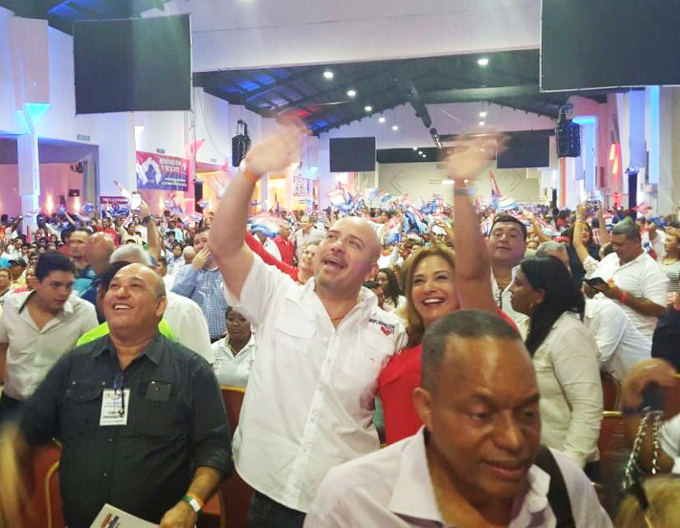
The Democratic Revolutionary Party (PRD), having in 2014 achieved its dubious historical first of having lost two national elections in a row, is still Panama’s largest political party at around 470,000 members. At the moment it looks like two parties, and beyond that first glance maybe more.
If one wants to jam it into an international context, the PRD is a member of the Socialist International and like almost all social democratic parties with working class followings it’s conflicted between those who accept globalization on corporate terms and its consequent oligarchic politics and those looking to establish or re-establish principles more closely aligned with more plebeian interests. In the current contest for control of the party apparatus, however, the neoliberal label might be stuck on either side but neither side is talking about that. Instead, the main bone of contention is whether the party’s legislative caucus ought to align itself with Ricardo Martinelli or with Juan Carlos Varela, at least for the moment.
A deeper ideological divide, like that in the British Labour Party (also part of the Socialist International) between leader Jeremy Corbyn and the party’s parliamentary caucus, or akin to the Democratic primary rumble between Hillary Clinton and Bernie Sanders, may well emerge within the PRD after this contest. The noteworthy critic of “free trade” as promoted from Washington who wants to be the party’s 2019 presidential nominee, former Agriculture Minister Laurentino “Nito” Cortizo, is not running in person or by proxy in the current contest. But former President Ernesto “Toro” Pérez Balladares is looking to make a comeback by the same route that brought him to the presidency in the first post-invasion elections back in 1994, via election as the party’s secretary general first. Toro is allied with Bocas del Toro legislator Benicio Robinson, who seeks to hold onto his current post as party president. Against them, not counting the also-rans, are Veraguas legislator Pedro Miguel González who is running against Toro for secretary general and former Health Minister Camilo Alleyne who is running for party president.
Robinson may formally head the National Assembly’s PRD caucus, but he can’t deliver the votes for his preferred alliance with Ricardo Martinelli, who also can’t deliver even a majority of the Cambio Democratico deputies for a coalition with Robinson. It’s González, who, with a group of PRD rebels, a larger group of CD rebels and the third-place Panameñista caucus, has his hands on a few of the legislature’s patronage levers.
Never let it be said that Robinson stands for any particular principle — he’s an old-style machine politician whose existence is predicated on distributing the spoils of political victory. His problem is that neither through the legislature and certainly not through the executive branch does he have access to any plums to pass out.
González carries the banner of reform, or at least takes that posture. He’s the leader of the Torrijista Rescue and Renovation Movement, an amalgam of several strains within the party, some of them leftist relative to the current and recent party leaderships. The movement’s argument is that the social reforming militarist Omar Torrijos stood for a certain set of principles during his 1968-1981 dictatorship and that these principles have been discarded over the years in favor of an unprincipled “what’s in it for me?” transactional politics, which led the party to a huge disaster in the Martinelli years when many of its elected officials were bought off by that now exiled former president’s offers of a share of the patronage plums. Young people seeking to join the party, they say, should to warned that they are signing up for public service rather than seats on a gravy train, and that there are certain nationalist and social justice principles that must be upheld.
But then, what was one of General Torrijos’s key operating principles? Like his model before him, General and then President José A. Remón, Torrijos hated Arnulfo Arias and his Panameñista Party. We can note the historical issues — Arnulfo’s tilt toward the Nazis in World War II, his racist constitution that stripped all non-Hispanic blacks, Arabs, Sephardic Jews and Asians of their citizenship, his cult of personality — but in any case the PRD, which Torrijos founded, and the Panameñistas are traditional enemies. Toro is playing that card and slamming González for allegedly selling out to the enemy.
The appearance is that while Toro wants to be president, González just wants to be kingmaker. That probably works to the former president’s disadvantage. It’s way early to be making 2019 predictions, but in mid-September a Dichter & Neira poll found that 40 percent of Panamanians were undecided about the possible party or independent offerings now out there or would not support any of them with Cambio Democratico leading the rest of the pack with 21 percent, the PRD with 19 and the Panameñistas with only 9. While more than one in five like Martinelli’s party, nearly everyone else thinks that Martinelli ought to be brought back to Panama and thrown in jail. Most people don’t like the strange alliance that runs the National Assembly, but Robinson and González are held in equally low public esteem as leader of the PRD. In July Dichter & Neira found Toro much more popular than either Robinson or González, but well behind Nito Cortizo. The notion that a PRD under Pérez Balladares’s leadership would be a return to a winning formula is not at all compelling.
And how might Washington, and Panamanians who take US advice seriously, see it? Officially, Ernesto Pérez Balladares is a crook who is ineligible for a US visa, while Pedro Miguel González is a terrorist to be arrested and put on trial for his life if ever Uncle Sam can lay hands on him. These are long stories, not all of which are on the public record. The US State Department makes no public comments on visa denials, but it is said that the main thing that Washington has against Toro is his selling of Panamanian ID to Chinese citizens attempting to illegally migrate to the United States. With González it’s a 1992 drive-by shooting that left an American soldier dead during the course of George H. W. Bush’s visit that was intended to be an election year victory lap. A Panamanian jury acquitted González but Uncle Sam doesn’t buy it.
The race is razor thin. In the July 31 elections of 4,200 convention delegates there was no clear winner. At the end of September 15 of the 26 congresillos — regional congresses — whose elected presidents become members of the PRD’s National Leadership Council (CDN) had been held, with the Robinson and Pérez Balladares faction taking eight to the Alleyne and González faction’s seven. On October 3 the congresillo in Panama City’s Circuit 8-7 nearly unanimously elected a unity slate headed by Calidonia’s long-time representante, Ramón Ashby Chial, who might be just enough of a machine politician to appreciate Robinson and just enough of a survivor to beware of Pérez Balladares — in any case he’s not overtly committed to either faction.
While that leaves the race for CDN seats tied or to a slight Pérez Balladares advantage, González’s faction is claiming more delegate votes in the process so far and it’s the delegates who will gather at the Figali Convention Center on October 31 and decide the races for president, secretary general and the eight other offices of the party’s National Executive Committee (CEN). The congresillos and the party congress at the end of the month, however, are bellwethers without much binding force. PRD legislators won’t have to obey the new party officers and it will be the rank-and-file membership, voting in a primary, who will choose the next PRD presidential nominee.
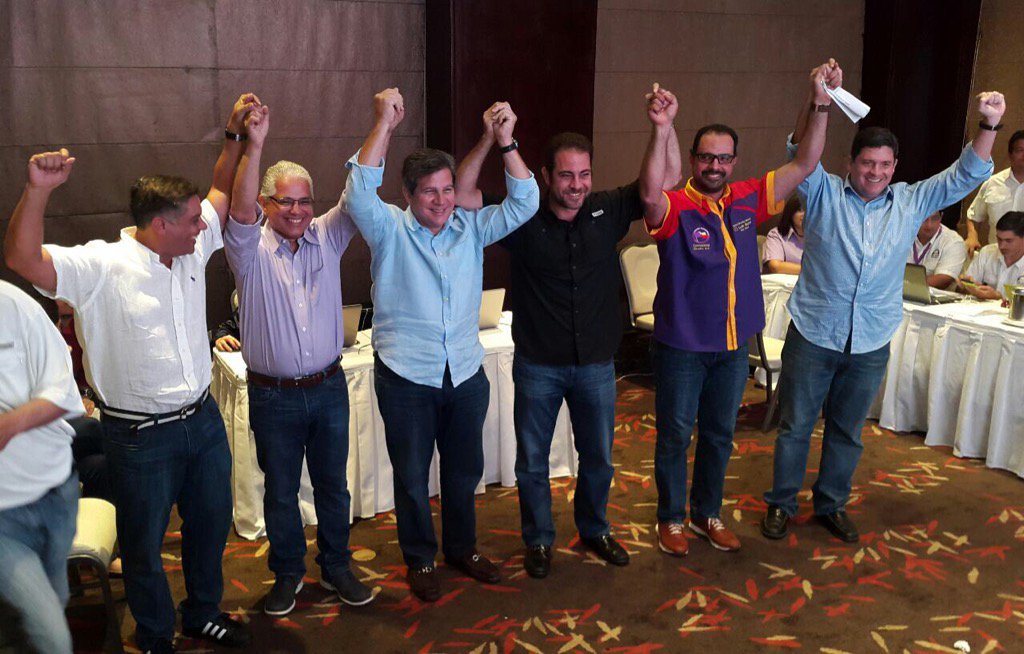
President Varela’s brother, legislator José Luis “Popi” Varela, has been elected as president of the Panameñista Party. Many observers are taking that as a sign of concentrated presidential power, some as the emergence of “Varelismo” that overshadows the “Arnulfismo” of the party that Arnulfo Arias founded, which traces roots farther back to the Accion Comunal movement of the 1920s. There are certainly large grains of truth to each of those propositions, probably more to the former.
Barely commented upon, and surely connected to the things that most reporters and pundits noticed, was who was and who was not in the lineup for the photographers after the party’s 1701 elected delegates voted on October 2 for the next generation of party leadership. There is an overlap among Panama’s business and political elites — the Varelas, for example, are wealthy scions of the Hermanos Varela liquor distilling fortune of Ron Abuelo and Seco Herrerano fame — and although the Panameñista Party does have a strong following among the poor those from the lower end of the economic scale were not in the picture. However, this iteration of Panameñista leadership concentrated control of the party in the hands of politicians at the expense of business leaders.
The last time that the party elected leaders Juan Carlos Varela was party president and Alberto Vallarino was first vice president. After the former took office as the president of Panama in 2014 he stepped out of his party post but Vallarino, one of Panama’s richest men and a nephew of Arnulfo Arias, did not step in as acting president. That distinction went to Ramón Fonseca, attorney and one of the two main partners in the infamous Mossack Fonseca law firm. Fonseca also took on the role of minister without portfolio in the current administration. Serving under Varela there were also a number of less prominent Mossacks and Fonsecas in the government.
Then came the Panama Papers revelations and the administration’s generally ham-handed response, which after a few weeks of evasion, denial and still ongoing protests of innocence included the exit of the Fonsecas and Mossacks from appointed government posts. Vallarino has had a less notorious public profile, but if one wants to get into how his fortune was enhanced there are plenty of examples of special tax breaks, questionable court decisions and other government favors along the way.
Ramón Fonseca Mora and Alberto Mora Clement are not in the new lineup of party leaders, and nobody of similar stripes came in to take their places. The new Panameñista leadership is almost entirely composed of politicians, with a few trusted activists who don’t currently hold any office in the mix. José Luis Varela is a member of the National Assembly. The new first VP, José Isabel Blandón, is the mayor of Panama City. Second vice president is Housing Minister Mario Etchelecu. Legislator Adolfo ‘Beby’ Valderrama is secretary general. Treasurer Carlos Duboys is the Varela administration’s wonk who measures how well the government is progressing toward accomplishing its stated goals. Party ethics and discipline chief Alcibiades Vasquez is Varela’s minister of social development.
So what might this tell us about “Varelismo?” Mainly that the president’s style is normally a cautious one, that while Panama is under fierce international criticism as a tax haven and money laundering center — which one would barely know if Panama’s corporate mainstream media were his or her only source of information — Varela is trying to reduce his political risks and put the party in the hands of people who are both less likely to be personally criticized abroad and are more astute about how things look in the political world. Critics will pan it as an aspect of Varela’s alleged “tortuguismo” — moving at a turtle’s pace. It might be seen in historical perspective as Varela’s tendency to bend with international political winds, something that Arnulfo Arias never did and which contributed to his several overthrows by military coups détat.
Other distinctions can be drawn between Juan Carlos Varela and Arnulfo Arias. Unlike the latter, Varela’s not an overt racist. If there is something to “Varelismo” it’s a centrist mix of conservative and progressive stands on different issues, a propensity to avoid confrontations if possible and a mixture of Latin American identity with deference to globalization on the terms set by multinational corporations. As the mid-point in this administration approaches, it appears that the Panameñistas are on course to maintain the post-invasion political norm and, like all incumbent parties, lose the next elections. If something dramatic that breaks this cycle happens, perhaps then it will be a better time to talk about Varelismo.
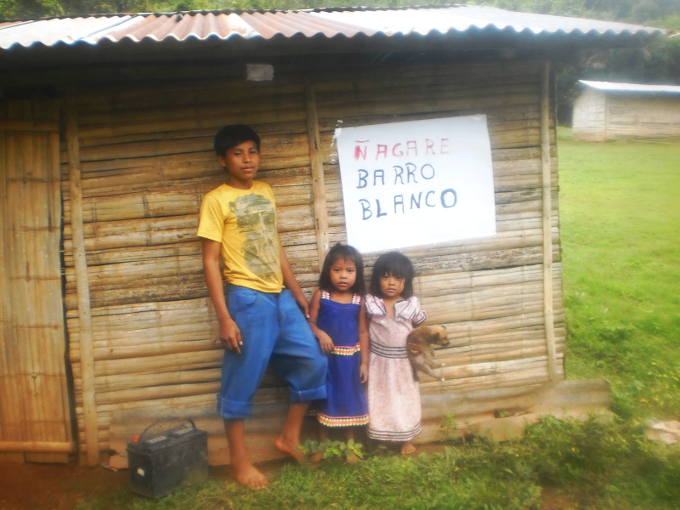
Al conmemorarse 524 años de agresión, genocidio y saqueo de un pueblo noble que lo recibieron como hermano en este continente ya habitado por orden del creador del cielo y la tierra, Dios Todopoderoso.
La Sociedad Civil Ngäbe-Buglé de Panamá invita a todos los pueblos originarios de la nación, organizaciones en general y pueblos panameños a una caminata el dia Miercoles 12 de Octubre desde las 9:00 am, partiendo desde Parque Urraca frente al hotel Miramar Intercontinetal hasta llegar a la Nunciatura Católica ubicado en Paitilla.
NO FUIMOS DESCUBIERTO.
NO FUE ENCUENTRO DE DOS CULTURAS.
LOS QUE OCURRIO ES UN GENOCIDIO.
Washington Post, Stunning photos of the PanCanal expansion
Hellenic Shipping News, New locks pompt new look for old equipment
The San Diego Union-Tribune, Bethancourt might be pitcher/catcher/outfielder
EcoTV, Gómez llama a jugadores para el amistoso de Panamá ante México
Baseball America, MLB moves Venezuelan Showcase tryouts to Panama
Mongabay, Program aims at Panamanian indigenous women’s food concerns
Telemetro, Britton: el fracaso de la educación panameña
PanARMENIAN.Net, Panama Papers leak dents new Panama incorporations
Reuters, Panamá registraría caída de hasta 20% en apertura de las SA
La Estrella, Préstamos nuevos al sector construcción cayeron 10.7%
Reuters, US Treasury steps up hunt for real estate money launderers
Dawn, Contract expiration ends US authority over Internet IP addresses
Apex Tribune, The death of the last Rabb’s Tree Frog
STRI, 26 jaguars killed in Panama so far this year
NBC, Are satellites the next cybersecurity battleground?
Business Insider, Google saves journalist hit by “record” cyber-attack
BBC, Medicine Nobel for cell recycling work
Video, Wall collapses at Costa del Este highrise construction site
InSight Crime, Panama requests Martinelli’s extradition
Kyiv Post, Former Ukrainian official makes bail in Panama
Diplomatic Intelligence, EU Lib Dems seek Panama Papers whistleblower protection
EFE, EEUU anticipa “decisiones difíciles” en Colombia
El País, El renacer de Álvaro Uribe
Video, FARC women and the challenges of a peace that hasn’t quite come
WOLA, Peace is still possible in Colombia
Piri, Shocking Colombian vote
Jung, On the ground with USAID in Honduras
Boff, The coups of 1964 and 2016: by the same class
ICIJ, Trump’s Iranian bank tenants
Russell, Dakota Access Pipeline: Legal encounters of the third kind
Jacobin, Chelsea Manning’s integrity
Weisbrot, Is Human Rights Watch too closely aligned with US foreign policy?
Barnes & Noble Reads, 11 books that were banned for ridiculous reasons
Fischer, The West on the brink
Stiglitz & Pieth, The real scandal behind the Panama Papers
Simpson, Cuando “La Percepción” ataca
Beluche: Donald Trump, el Martinelli yanqui
Flores, La necesaria transformación universitaria
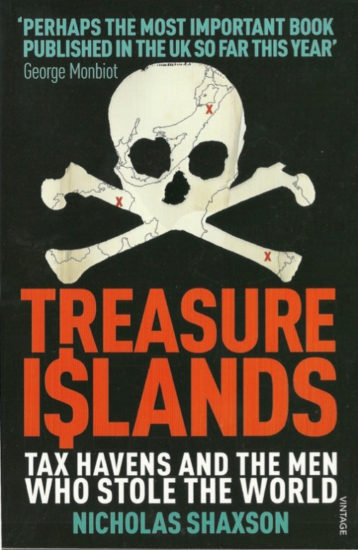
Just six months ago the Panama Papers, just six months ago, shook countless governments and rulers, media, financial centers and banks from east to west and north to south, with the exception of Panama. That’s not to mention the citizen reactions in several countries, where important figures were exposed unseated.
The Panamanian government has managed to cover with a blanket of protection and concealment — larger than the ridiculous pink tarp on El Valle’s India Dormida — the irreparable damage that their complicity in this matter has meant to our people.
A recent article by Joseph Stiglitz and Mark Pieth comes back to expose the Varela administration and its double standard on the subject of the Panama Papers.
It thus makes it worthwhile, for its importance and relevance, to read what Nicholas Shaxson offers us in his book, Las Islas del Tesoso: los paraísos fiscales y los hombres que se robaron el mundo (Buenos Aires, Fondo de Cultura Económica 2013) — find its original English version here. It’s a rich investigation of why tax havens are not only found in the heart of the global economy, but also the most important reasons why poor people and poor countries remain poor.
The 500 pages of this book forthrightly show us that this extraterritorial system of tax havens concentrates the ties between the criminal underworld and the financial elite, and links the senior leaders of diplomatic and intelligence services with multinational firms. It’s the way power operates today, and it has concentrated wealth and power in the rich more strongly than any other historical event. However, its effects have been almost invisible.
In Panama, where media manipulation has kept people from knowing what has happened and why there are tax havens, this is required reading.
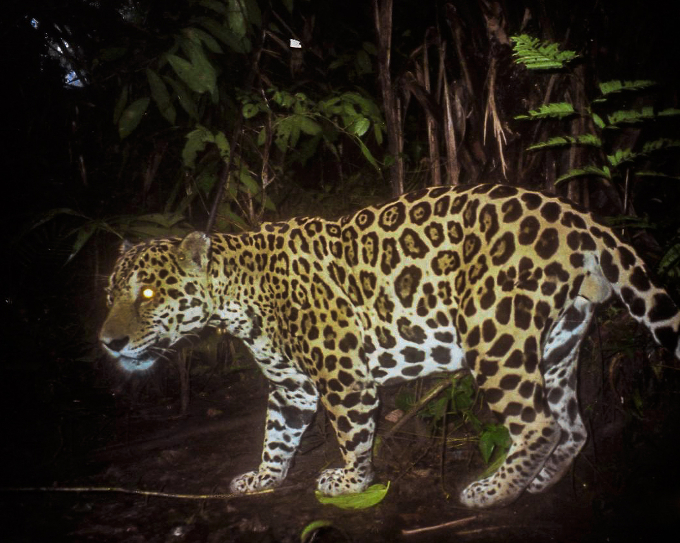
En Panamá han muerto 26 jaguares en lo que va del año
por STRI, fotos por la Fundación Yaguará Panamá
En el XX Congreso de la Sociedad Mesoamericana para la Biología y la Conservación que se llevó a cabo recientemente en Belice, Ricardo Moreno, investigador asociado en el Instituto Smithsonian de Investigaciones Tropicales (STRI) en Panamá y director de la Fundación Yaguará Panamá, informó que el número de jaguares que han matado en Panamá va en aumento.
“Tenemos evidencia de que se mataron un mínimo de 230 jaguares en Panamá entre 1989 y el 2014”, comentó Moreno. “Tenemos razones para pensar que el número real puede ser de dos o tres veces mayor. En el 2015 mataron a 23 jaguares. En el 2016, hasta septiembre, hay reportes de 26.”.
Moreno y sus colegas reunieron los informes de estas muertes entre una amplia gama de personas, desde guías turísticos a ganaderos. La mayoría de los casos eran en represalia por la depredación de ganado vacuno, ovejas y perros.
En la reunión, los investigadores evaluaron el estado de conservación de los animales desde México hasta Panamá y la salud de los bosques en el Corredor Biológico Mesoamericano que se extiende a lo largo de la costa atlántica de América Central.
Moreno compartió los resultados recopilados durante los inventarios con cámaras-trampa que se llevaron a cabo desde el 2005 hasta el 2014 por un equipo dirigido por Ninon Meyer, en ese entonces estudiante de doctorado con Patrick Jansen, científico de STRI y profesor de la Universidad de Wageningen, en 15 parques nacionales y en fragmentos de bosque en ambos lados del Canal de Panamá. Los investigadores se preguntaron hasta qué punto los bosques que aún quedan puedan apoyar la diversidad de vida silvestre.
“Sabemos por el trabajo reciente de los geólogos y paleontólogos en el Smithsonian que el puente terrestre que conecta a Panamá con América del Norte y del Sur se formó hace 2.8 millones de años”, comentó Moreno. “La conexión se interrumpió hace 100 años por la construcción del Canal de Panamá. El desarrollo continuo y la deforestación de Panamá Central está interrumpiendo el flujo de los animales y sus genes, de modo que ahora el jaguar es considerado una especie en peligro de extinción”.
Moreno especula que la continua expansión de la agricultura y de nuevos proyectos de desarrollo urbano, además del desarrollo de la minería y las represas están limitando las poblaciones de jaguares a áreas escarpadas y montañosas. Un aumento en el consumo humano de las principales especies de presa los jaguares también exacerba la depredación de animales domésticos por parte del jaguar.
Los participantes en un seminario sobre la situación actual del pecarí de labios blancos (Tayassu pecari) reportaron la disminución de poblaciones de pecaríes en toda la región y la falta de conectividad entre áreas boscosas necesaria para la reproducción de poblaciones sanas.
El pecarí de labios blancos, único de los trópicos americanos, vive en enormes grupos de 10 a 300 individuos y juegan un papel importante como arquitectos de las comunidades forestales, estructurando el bosque mediante la dispersión de semillas de árboles y el pisoteo de las plantas. Los grupos indígenas siempre han cazado pecaríes, pero con el avance continuo de las fronteras agrícolas, los ranchos ganaderos, nuevas carreteras y proyectos de desarrollo a gran escala en toda la región, esta especie está en peligro de extinción. Los pecaríes son una de las especies principales en la dieta del jaguar, y cuando los cazadores persiguen los pecaríes, a menudo también matan a los jaguares.
El pecarí de labios blancos, el jaguar (Panthera onca) y el tapir (Tapirus bairdii) son indicadores de ambientes tropicales sanos. Estas tres especies han desaparecido en áreas importantes de la sección panameña del Corredor Biológico Mesoamericano.
El Istmo de Panamá ya ha perdido más de la mitad de su bosque. Los autores del estudio con cámaras-trampa informaron que a pesar del hecho de que más del 22 por ciento de la superficie terrestre de Panamá se encuentra bajo alguna forma de protección, varios parques nacionales no están apoyando el número esperado de animales.
Los proyectos de restauración forestal, tales como el Proyecto de Agua Salud dirigido por el científico de STRI, Jefferson Hall, muestran que es posible recrear el hábitat del jaguar en la región. Moreno y Meyer, en un artículo publicado en el boletín de la Unión Internacional para la Conservación de la Naturaleza “Noticias del gato,” hacen un llamado a tomar las siguientes medidas para salvar a los jaguares restantes:
La educación, especialmente en las zonas donde el número de muertes de jaguares es alto.
Los programas de extensión para los ganaderos que han experimentado la depredación por jaguares.
Los incentivos económicos para las comunidades rurales cercanas al hábitat del jaguar. En una comunidad, los residentes han vencido las pérdidas debidas a la depredación por medio de la venta de huellas de jaguar en moldes de yeso.
La creación de alianzas multi-institucionales para unir a las instituciones gubernamentales y no gubernamentales p ara intervenir en áreas clave.
“La educación es clave, ya que todos merecemos entender lo que está sucediendo en nuestro planeta y en nuestros países”, comentó Moreno. “Pero la educación lleva años y los jaguares y pecaríes no les quedan años”.
“Esperamos que nuestra excelente presentación de informes científicos sobre la situación de estos animales en la región se considere relevante”, comentó Moreno. “Hemos escrito planes de acción. Tenemos los conocimientos necesarios para reorientar la política con el fin de conservar a los jaguares, pecaríes y los bosques en toda la región. En Panamá, la Fundación Yaguará Panamá cuenta con el apoyo del Ministerio de Ambiente. La conservación del jaguar tomará dedicación por parte de los gobiernos, las ONG y las personas apasionadas unidas para conservar nuestro patrimonio natural, que no tiene fronteras”.
El Instituto Smithsonian de Investigaciones Tropicales, en ciudad de Panamá, Panamá, es una unidad de la Institución Smithsonian. El Instituto promueve la comprensión de la naturaleza tropical y su importancia para el bienestar de la humanidad; capacita estudiantes para llevar a cabo investigaciones en los trópicos; y fomenta la conservación mediante la concienciación pública sobre la belleza e importancia de los ecosistemas tropicales.
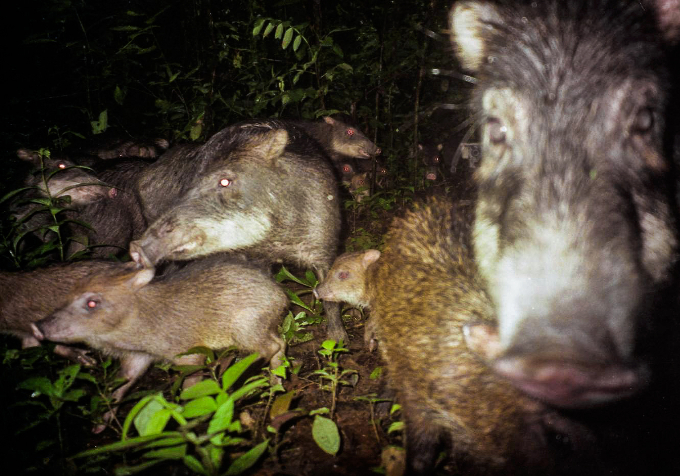
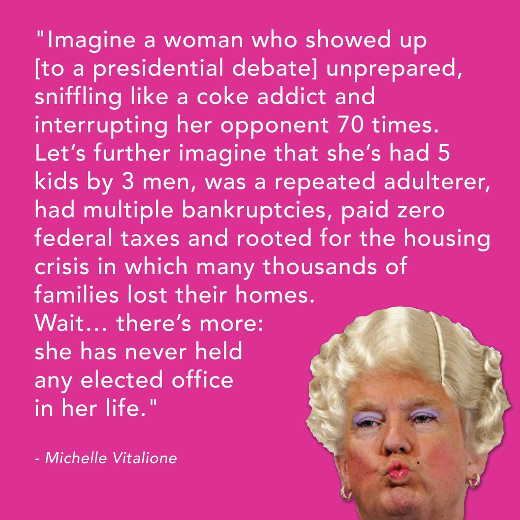
Hillary Clinton: a choice that matters, and to which there is no viable alternative
For the first time in its 126-year history, the Arizona Republic has endorsed a Democratic presidential candidate. For the first time in its 34-year history, USA Today has made an endorsement of sorts — a negative one, with a positive nod toward no candidate but a plea not to vote for Donald Trump. “Trump has demonstrated repeatedly that he lacks the temperament, knowledge, steadiness and honesty that America needs from its presidents,” the USA Today editors concluded.
The corporate liberals who run The New York Times and the neocons who dominate the Washington Post have been savaging Trump for some time, as could have been expected. Many Republican national security policy makers have also raised an alarm about the man.
So should that be a sign that those of us who were skeptical about NATO support for Portuguese colonialism between the bloc’s foundation and the mid-1970s and look askance at the alliance’s moves up to the post-Soviet Russian borders ought to take a fresh look at Trump, who vows to end the “attack on one is an attack on all” principle of that Cold War institution? Were he a pacifist or an isolationist, it would be a different set of calculations. Trump would go around the world attacking other countries with the rest of the world standing back appalled — the lack of solidarity and empathy cuts both ways and in a belligerent person or nation the pariah status that such an attitude creates is particularly dangerous. Antiwar voters who fear that Hillary Clinton may be an incurable warmonger have nothing to gain from the Trump alternative and everything to lose by casting a protest vote for a third-party candidate and passively letting Trump into the White House with a narrow plurality. Abolishing, abandoning or altering NATO might be reasonable propositions to consider, in consultation with the other members. Turning US foreign policy into a shakedown racket, whether to make Eurpeans pay the bloated Pentagon budget or to make the Mexicans pay for a pharaonic and futile wall would be a catastrophe. You see, some alternatives to a widely and reasonably despised established order would be changes for the much worse.
Libertarian candidate Gary Johnson and Green candidate Jill Stein deserve a respectful hearing and after their campaigns are footnotes in history Americans would be well served if some of their better ideas are picked up and championed by mainstream politicians. Johnson, a former governor, is not nearly so clueless as his widely publicized senior moments of memory loss make him appear to be. Stein, who has never held public office, might serve herself and her movement well by getting elected to a public office that’s realistically within her reach. But notice that Johnson’s and Stein’s respective weaknesses show up in more virulent form in Donald Trump. Stein doesn’t know the ropes from personal experience, but she has a sober and realistic view of how the US government works and some proposals to change some of that. Trump seems to think that he can snap his fingers and things will be done, but acting out such a fantasy would lead to a constitutional crisis in short order. Johnson has spells of being at a loss to identify names and places, while Trump’s convenient “memory lapses” are nothing of the sort, but rather crude attempts to deceive.
Thus so many Americans who may dislike the woman, or who might find her pleasant enough even as they reject her ideas, are left with one viable option, Hillary Clinton for president. With Clinton, the solace for those who have this or that objection isn’t just that Trump would be worse. It’s that some semblance of a rational public discourse would continue, in which well meaning people could affect the course of events and build movements for their various causes during a Clinton administration. Under a Trump administration such folks would be on the run from a lynch mob.
The choice that Americans face at the top of the ticket — including US citizens living abroad, who have the right to vote and should use it — may not be the happiest one for everybody. But from Bernie Sanders to George H. W. Bush there is an emerging consensus. Hillary Clinton is the only candidate for US president who might win and who can actually do the job.
Bear in mind…
What hurts and discourages is to be ignored.
Clara González de Behringer
The revolution wasn’t great for what we did, but more for what we didn’t undo.
Pepe Figueres
The art of winning is learned in defeat.
Simón Bolívar

Séptima Raiz – De frente con Jah
https://youtu.be/frTxQHpWpf0
The Mighty Sparrow – Only A Fool
https://youtu.be/-7IaAqAp6kc
Nina Simone – Obeah Woman
https://youtu.be/gZxnwrGPQEs
Lord Cobra – Racombey
https://youtu.be/ZK89Ngv84K0
Sinéad O’Connor – Vampire
https://youtu.be/-mtCFE-CkM8
Rita Marley – Harambee
https://youtu.be/GlQgC5IyPHw
Chubby Checker – Limbo Rock
https://youtu.be/iTKj_Vd5_Bk
Binghiman & the Natives – Mal Trago
https://youtu.be/IgiOMLKV_zg
Johnny Cash & Joe Strummer – Redemption Song
https://youtu.be/lZBaklS79Wc
Lord Kitty – Neighbor Neighbor
https://youtu.be/-7IaAqAp6kc
Trouble Gyal Riddim – Aisha Davis, RR & Marcy Chin
https://youtu.be/NAZbneJHcZA
Kafu Banton & Almirante – Ella
https://youtu.be/mLedvhjWp1k
Alika & Mad Professor – The Nyabinghy Chant
https://youtu.be/5kYaeyif4u8
Yomira John – Mama Congo
https://youtu.be/C48fi2qtKn8
Aswad – Distant Thunder Hammersmith 1988
https://youtu.be/QC_kAeYUg4Q